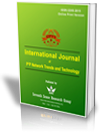Classification of Touch Spam in Mobile Ad Networks using Bi-Partite Graph
 |
International Journal of P2P Network Trends and Technology (IJPTT) |  |
| © 2017 by IJPTT Journal | ||
| Volume-7 Issue-6 |
||
| Year of Publication : 2017 | ||
| Authors : M. Sree Vani |
Citation
M.Sree Vani "Classification of Touch Spam in Mobile Ad Networks using Bi-Partite Graph". International Journal of P2P Network Trends and Technology (IJPTT).V7:19-24 November to December 2017. ISSN:2249-2615. www.ijpttjournal.org. Published by Seventh Sense Research Group.
Abstract
A touch user interface (TUI) is a computer-pointing technology based upon the sense of touch (haptics). Touch-spam is a type of fraud that occurs over TUI gadgets ex. Smartphones, tablets, phablets, touch laptops etc. It actually happens in TUI applications when a person, automated script, computer program or robotic action imitates a legitimate user of a TUI application touching on an advertisement (ad), for the purpose of generating a charge per touch without having actual interest in the target of the ad’s popup. Touch-spam is becoming an issue due to the advertising networks being a key beneficiary of this spam. In present days, smartphone gaming applications (apps) are playing a vital role to attract mobile-advertisements (ads) since their pocket portability and other versatile features. Popular apps are able to read the user personalized data to process user interests helping to generate customized ads. Touch-spam in smart phone apps is a fraudulent or invalid tap or touch on online ads, where the user has no actual interest in the advertiser’s site. It requires a user touch on online ads that pop-up dynamically in smartphone gaming apps. It all need the user to tap the screen close to where the ad is displayed .While the ad networks continue taking active measures to block click-spam today, the touch-spam still creeping under the TUI. It is being used by spammers to misappropriate the advertising revenue. The presence of touch-spam is largely unknownThen we propose a node-tag propagation algorithm on click-through logs to identify spam Apps in Smartphone-game Apps. We validate our methodology using click/touch-log data from major ad network. Our findings highlight the extremity of the spam in mobile advertising.
References
[1] M.Najork. Web spam detection. In L. Liu and M. T.•Ozsu, editors, Encyclopedia of Database Systems, pages 3520{3523. Springer US, 2009.
[2] Googleadmob. ttp://www.google.com/ads/admob/.
[3] iadappnetwork. http://developer.apple.com/support/appstore/iad-app-network/.
[4] Microsoft advertising. http://advertising.microsoft.com/en-us/splitter.
[5] S.Alrwais, A. Gerber, O. Spatscheck,M. Gupta, and E. Osterweil. Dissecting ghost clicks: Ad fraud via misdirected human clicks. ACSAC, 2012.
[6] T.Blizard and N. Livic. Click-fraud monetizing malware: A survey and case study. 2012.
[7] P.Chia, Y. Yamamoto, and N. Asokan. Is this app safe? a large scale study on application permissions and risk signals. In WWW, 2012.
[8] V.Dave, S. Guha, and Y. Zhang. Measuring and fingerprinting click-spam in ad networks. In ACM SIGCOMM, 2012.
[9] C.Cadar D. Dunbar and D. Engler. Klee: In USENIX OSDI, 2008.
[10] P.Gilbert, B. Chun, J. Jung. Vision:automated security validation of mobile apps at app markets. In MCS, 2011.
[11] H.Haddadi. Fighting online click-fraud using bluff ads. ACM Computer Communication Review, 40(2):21–25, 2010.14
[12] C.Hu and I. Neamtiu. Automating gui testing for android applications. In AST, 2011.
[13] A.MacHiry, R. Tahiliani, and M. Naik. Dynodroid: An input generation system for android apps. In FSE, 2013.
[14] A.Mesbah and A. van Deursen. Invariant-based automatic testing of ajax user interfaces. In ICSE, 2009.
[15] Ali Mesbah, Arie van Deursen, and Stefan Lenselink. Crawling ajax-based web applications through dynamic analysis of user interface state changes. ACM Transactions on the Web, 6(1):1–30, 2012.
[16] A.Metwally, D. Agrawal, and A. El Abbadi. Detectives:Detecting coalition hit inflation attacks in advertising networks streams. In WWW, 2007.
[17] A.Metwally, F. Emekci, D. Agrawal, and A. El Abbadi.Sleuth: Single-publisher attack detectIon using correlation hunting. In PVLDB, 2008.
[18] B.Miller, P. Pearce, C. Grier, C. Kreibich, and V. Paxson. What’s clicking what? techniques and innovations of today’s clickbots. In DIMVA, 2011.
[19] L.Ravindranath, J. Padhye, S. Agarwal, R. Mahajan,I. Appinsight: mobileapp performance monitoring inthe wild. In USENIX OSDI, 2012.
[20] W.Yang, M. Prasad, and T. Xie. A grey-box approach for automated gui-model generation of mobile applications. In FASE, 2013.
Keywords
spam, mobile apps, click spam, bi-partite graph.

